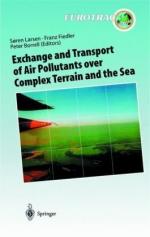|
This section contains 914 words (approx. 4 pages at 300 words per page) |

|
Air contamination is divided into two broad categories: primary and secondary. Primary pollutants are those released directly into the air. Some examples include dust, smoke, and a variety of toxic chemicals, such as lead, mercury, vinyl chloride and carbon monoxide. In contrast, secondary pollutants are created or modified into a deleterious form after being released into the air. A variety of chemical or photochemical reactions (catalyzed by light) produce a wide range of secondary pollutants especially in urban air. A prime example is the formation of ozone in smog. A complex series of chemical reactions involving volatile organic compounds, nitrogen oxides, sunlight, and molecular oxygen create highly reactive ozone molecules containing three oxygen atoms. Stratospheric ozone in the upper atmosphere provides an important shield against harmful ultraviolet radiation in sunlight. Ozone in ambient air (that surrounding us) is highly damaging to both living organisms and building...
|
This section contains 914 words (approx. 4 pages at 300 words per page) |

|


